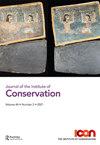A technical examination of the nature and significance of prismatic lead white
IF 1
0 HUMANITIES, MULTIDISCIPLINARY
引用次数: 1
Abstract
Abstract Prismatic lead white was first described by Walter C. McCrone in 1983 when it was identified via polarised light microscopy in three paintings by Edouard Manet. It is characterised by crystals in the shape of bullets or pills (i.e. prism-shaped, hence ‘prismatic lead white’). McCrone attributed the formation of these crystals, morphologically distinct from those of ‘normal’ lead white, to processing conditions characteristic of precipitated lead white. These ‘prismatic’ crystals have subsequently been identified as cerussite (orthorhombic lead carbonate, PbCO3). Their presence has been tentatively used to date artworks painted from the nineteenth century onwards. The article will show, through reproducing historic pigment recipes of post-treatments, that prismatic lead white can also be formed in the stack lead white process and so its presence should not be used as a criterion for dating. This article investigates the formation of these prismatic crystals in the context of the manufacture and history of lead white.棱镜铅白性质及其意义的技术检验
1983年,Walter C. McCrone通过偏光显微镜在爱德华·马奈的三幅画中发现了棱柱状铅白。它的特点是子弹或药丸形状的晶体(即棱柱形,因此“棱柱形铅白”)。McCrone将这些晶体的形成归因于沉淀白铅的加工条件,这些晶体在形态上与“正常”白铅不同。这些“棱柱状”晶体随后被鉴定为铈矿(正晶型碳酸铅,PbCO3)。它们的存在被暂时用于确定19世纪以来绘画作品的年代。本文将通过再现历史上后期处理的颜料配方来说明,棱柱状的铅白也可以在堆积铅白的过程中形成,因此它的存在不应该作为测年的标准。本文在白铅的制造和历史背景下研究了这些棱柱状晶体的形成。
本文章由计算机程序翻译,如有差异,请以英文原文为准。
求助全文
约1分钟内获得全文
求助全文
来源期刊

Journal of the Institute of Conservation
HUMANITIES, MULTIDISCIPLINARY-
CiteScore
1.50
自引率
0.00%
发文量
22
期刊介绍:
The Journal of the Institute of Conservation is the peer reviewed publication of the Institute of Conservation (Icon). As such, its aims reflect those of Icon, to advance knowledge and education in conservation and achieve the long term preservation and conservation of moveable and immoveable cultural heritage. The Journal provides a collective identity for conservators; it promotes and supports both the profession and professionalism. With international contributions on all aspects of conservation, it is an invaluable resource for the heritage sector. The specific aims of the Journal are to: 1. promote research, knowledge and understanding of cultural heritage conservation through its history, practice and theory 2. provide an international forum to enable and disseminate advances in research, knowledge and understanding relating to conservation and heritage 3. champion and support professional standards of heritage conservation in the UK and internationally 4. provide a permanent record of issues relating to conservation and heritage 5. be financially and operationally sustainable. To achieve these aims, the Journal invites contributions from all those involved in the conservation of cultural heritage and related activities. Areas of interest include understanding cultural heritage materials and their degradation; subject reviews and histories of cultural heritage materials and conservation treatments; new, innovative or improved approaches to conservation and collections care theory, practice, communication, management and training; case studies demonstrating new, innovative or improved approaches; and conservation in its wider context. Submitters are encouraged to demonstrate how their work is of practical application to conservation. To maintain professional standards and promote academic rigour, submissions of articles and shorter notices are subject to an anonymous peer review process.
 求助内容:
求助内容: 应助结果提醒方式:
应助结果提醒方式:


